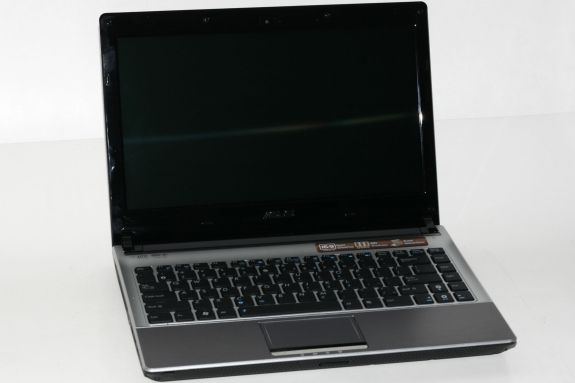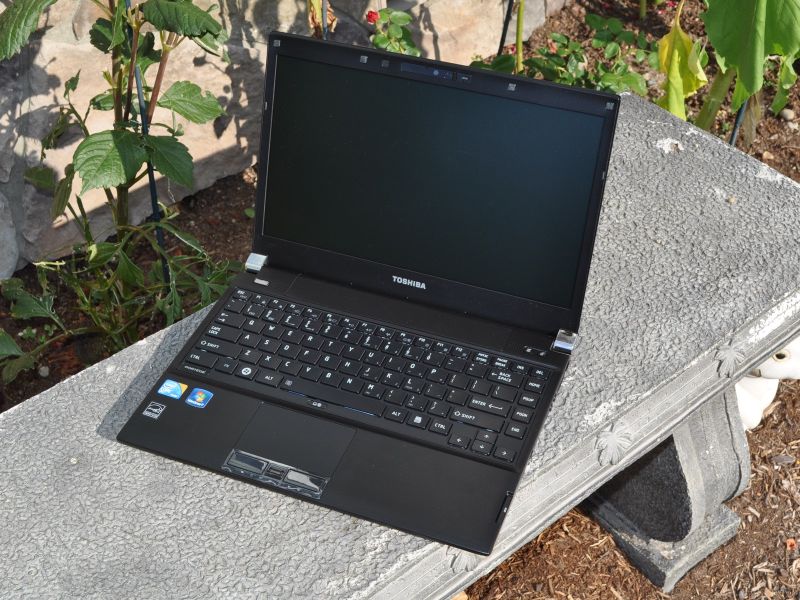Holiday Buyer's Guide: Notebooks
by Dustin Sklavos on November 15, 2010 9:00 PM EST- Posted in
- Laptops
- Guides
- Holiday 2010
Best Ultraportable: ASUS U30Jc/U35Jc ($779/$750)
The ASUS U30Jc wound up bringing home our editors' choice award when we first reviewed it, so it should come as no surprise that we'd be keen to recommend it here. It's getting a little long in the tooth, but the overall build quality and features are still worthy of recommending.

While the GeForce 310M graphics are virtually bereft of useful performance, we found the rest of the notebook to be plenty capable and able to produce exceptional battery life. In fact, it's this kind of performance and battery life that makes netbooks increasingly difficult to recommend: slightly bigger, much better machines are lasting longer on the battery.
The U35Jc variant is more or less the same machine as its slightly bigger brother, with the difference being that it eschews the integrated optical drive the U30Jc tags along. We're finding more and more these days that an optical drive just isn't the must-have kit it used to be: most operating systems can be installed via USB, and most gamers at this point are using Steam (or other similar options) to get their fix.
Either one of these notebooks is able to produce nearly eight hours of useful battery life, no mean feat for machines with dedicated graphics and mainstream (albeit low-end) Intel Core i3 processors. If they have one major flaw, it's that ASUS continues to hamstring their computers with mediocre screens, but we think the trade-off is absolutely worth it.
There's also the slightly rarefied U33Jc variant that includes USB 3.0, Intel's WiDi technology, and a bamboo shell. It's more expensive, but if you're gunning for style or think you might actually use WiDi (Vivek's in love with it), the U33Jc is an equally respectable choice.
Ultraportable Runner Up: Toshiba Portégé R700 ($945)
While Vivek was unimpressed with the blinged-out Protege R700 that Toshiba sent us for review, he submitted that the more affordable, trimmed down versions would be a lot more compelling and we certainly agree.
The Toshiba Protege brings the full line of Intel Core 2010 processors to bear in a remarkably small chassis—that's excellent mobile CPU performance in a three-pound laptop. It can't quite scrape the kinds of battery numbers we see from the ASUS U30/U33/U35 notebooks, and it doesn't have the questionable benefit of NVIDIA's low-powered dedicated graphics, but the R700 is lighter than the competition and more readily found in retail. It's also $100 more than the ASUS offerings above, so you win some and lose some.
Other Alternatives
Other alternatives certainly exist, including a lot of last-generation CULV laptops that can still get incredible battery life and cost $600 or less. We'd love to recommend the Sony VAIO Z-series as well, because it has some awesome features, but with prices starting at $1800 you need to be dedicated to the ultraportable lifestyle before making the move. Similarly, the VAIO Y-series weighs more and uses i3/i5 ULV processors, which frankly underwhelm—you can get almost the same battery life from full i3 processors running at twice the clock speed. If you can live with the "floating island" keyboard, you might even look at the Acer TimelineX laptops. Overall, though, we think the U/UL-series laptops from ASUS continue to offer the best ultraportable package without breaking the bank.











50 Comments
View All Comments
Cuhulainn - Monday, November 15, 2010 - link
Though I agree with your subject, I'd disagree with the rest. If what you say were true, you'd see high quality LCD options on every laptop, and no glossy plastic enclosures. Manufacturers will continue to make what they believe meets the needs of the market, regardless of what review sites say. Sure, they have some influence, but it's not as though their hands are tied because of these review sites.I like to have the option, especially with Optimus and the like negating power concerns. If volume and weight are concerns, there are still plenty of options without discrete GPUs.
Relax.
beginner99 - Tuesday, November 16, 2010 - link
this.And most casual gamers play on console anyway and not pc.
I would easly pic a i3 IGP + mate 16:10 screen over a discrete one with useless a glossy 16:9 screen.
But for that you need to pay the 500$ "business fee", meaning less power for a 150% price tag.
BrooksT - Monday, November 15, 2010 - link
Could you guys *be* less professional?How about "if you're willing to pay a premium for design and build quality, and accept somewhat lower performance", etc.
Calling it an "Apple tax" is as silly as talking about the "Intel tax" if you opt for a super-premium CPU. Governments impose taxes; companies offer competing value propositions.
And then you get the whole implication that you don't get anything for a tax, which takes us into the political realm.
Please, guys, grow up a bit and take Anandtech in the direction of actual journalism. It's a premium, a tradeoff, a sign of different priorities, a trap for the unwary even, but it is most certainly not a "tax" by any remotely sane definition of the word.
max347 - Tuesday, November 16, 2010 - link
This comment is ridiculous.Obviously someone is getting too old for technology. "actual journalism" is found in newspapers....which my 50 year old dad doesn't even read anymore.
"Apple tax" is a common, well-known piece of jargon. Perfectly acceptable considering the audience and medium.
If you want PC language with oldtyme verbiage and stiffly written articles, read a newspaper. I think the way these articles are presented is just fine.
Aslo though, you could start up your own tech review site, and see how that turns out. I am betting if you take the "actual journalism" route you outline, you will have every stickler and wise guy tearing apart every little mistake in an article. Presented the way they are here, readers can more comfortably approach the writers, and have more of a discussion-style look at the product in question. This is why companies send them things to review- they get feedback. With a stringent fact-article approach, I don't think you would see this level of interaction.
JonBird - Tuesday, November 16, 2010 - link
I totally agree. It was an uncharacteristically low brow comment from a site that I think of as being in the top tier of tech journalism. Aanand must not have edited this article because he would never discredit his site by using this type of non-descriptive fanboy meme.JarredWalton - Tuesday, November 16, 2010 - link
I'll just say this: I specifically asked Anand to look over the MacBook page and make any comments/edits he saw necessary. What you didn't offend him, and he uses a MacBook Pro 15 all the time. Even he will admit that you pay a significant price premium for what amounts to build quality and aesthetics, and that is the "Apple tax" so often referred to. It's such a well-known term that you can even Google definitions, and get stuff like this:http://www.pcmag.com/encyclopedia_term/0,2542,t=Ap...
Osamede - Tuesday, November 16, 2010 - link
Whatever you want to cal it - "Apple tax" is really a polite way of putting it. If someone wanted to be more provocative they could even call it an "Apple cult fee". And Even the marketing term for this: "brand premium" is itself a euphemism for commanding a price over and beyond the intrinsic value of the product when separated from the brand loyalty.A good example of this is the new Macbook Air products. Basically you have in the 11" version what is little more than an Acer 1810 encased in a shiny aluminum package with a few ounces shaven off and the price doubled. The main real value in there is the better screen and that alone cannont explain Apple's blatant price gouging on 2-3 year old CULV products.
So I would say, let them call it what they will. Apple is definitely charging more than what the products are intrinsically worth.
Spazweasel - Tuesday, November 16, 2010 - link
"Intrinsic worth" is subjective.If you add up the cost of components, you don't get to call that "intrinsic worth", because assembly isn't free. Neither is design and engineering. Many people assign no value to this, and that's just plain wrong. Apple spends more on engineering and design than most other companies, and you pay your share of it. Apple's not the "R&D and manufacturing welfare company", nor is Dell or HP or Lenovo or Asus or any other laptop maker.
You also get OS/X with your MacBook, and that's not free either (and please, no BS about "it's FreeBSD/Mach", that's a tiny part of the operating system as a whole). If you choose to throw away the OS and run something else on it, fine, but you're going to pay your amortized part of OS/X's development anyway.
Look, if you don't value where the "extra" money is going, fine, DON'T BUY IT. You're saying "if I, and only I, don't value it, it has no value to anyone and should therefore be free".
Dustin Sklavos - Tuesday, November 16, 2010 - link
Respectfully, Apple's reported profit margins border on the offensive.You would LIKE to justify the increased cost based on all the things you listed, but judging by Apple's current liquidity I'm gonna go ahead and say these things have already been paid for. The rest is just gouging the consumer.
misaki - Monday, November 15, 2010 - link
I believe you guys have the model number wrong for the 2nd asus netbook, 1015pn-mu17 doesn't exist. Your link goes to 1015ped-mu17 which has the n455.1015pem is the n550 counterpart with integrated intel gpu that has 2 versions. MU17 is cheaper by leaving out bluetooth 3.0 and has a smaller battery than PU17.
(I happened to be looking at netbooks recently)